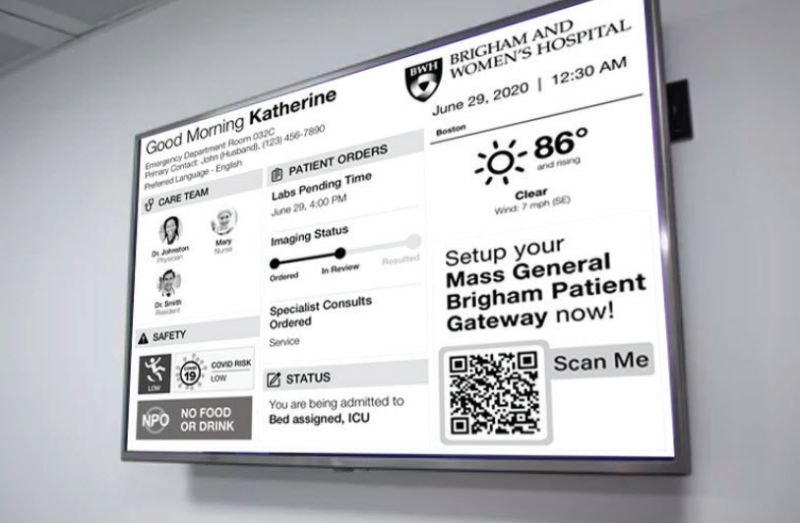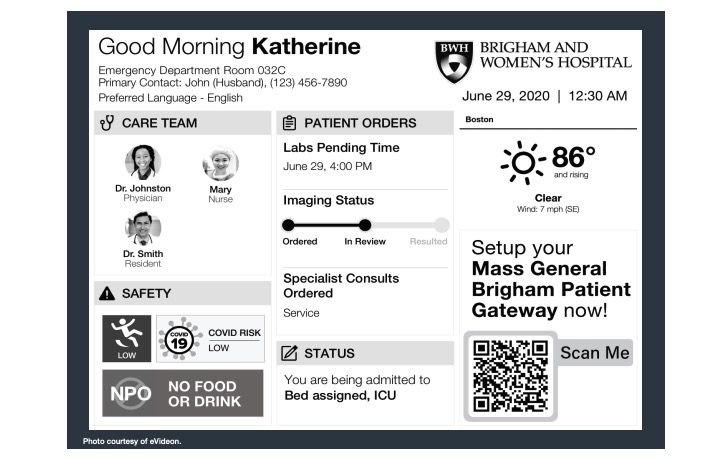
Study Suggests High Affinity For Digital Messaging Displays In Patient Care Environments
October 19, 2021 by Dave Haynes
Selling non-medical technology solutions into the health care sector is long and involved at the best of times, but in the COVID-era even more so. But health care presents what is likely a big opportunity for companies who decide to go after it with solutions that directly address operational pain points.
The e-paper giant E Ink has developed an interesting paper that looks at the positive impacts of converting patient room messaging from dry erase marker boards to digital versions, based on a study at the Brigham and Women’s Hospital in Boston. “The results were overwhelmingly positive,” the paper suggests. “When given the opportunity to have a room with a digital whiteboard versus one without, 96 percent of study participants preferred having one.”
The digital whiteboard used for this study involved hardware from Avalue, a software interface developed by patient engagement partner eVideon, and a 42-inch E Ink digital paper screen you could think of as a giant Kindle.
eVideon’s digital whiteboard software was integrated with the hospital’s electronic medical records (EMR) databases and programmed to update automatically when new information came available, removing the obligation of caregivers scribbling in updates by hand (if they had a chance and could find a marker) and hoping it was legible.
The software was highly customizable to display personal information – in this case including the name of the patient, the names of the care team, the patient’s preferred language, the status of lab orders and test results, the local weather report, and vital patient safety information such as COVID status and fall risk level.
The whiteboard software can also be customized to facilitate deeper engagement with the organization. In this particular study, the software displayed QR codes that gave patients and their families the ability to easily access the hospital’s patient engagement portal. The software can change the language displayed on the whiteboard at any time with the push of a button.

The test done for several months earlier in 2021 involved 50 patients who had a digital whiteboard in their room during their hospital stay, and 50 who did not, aka the control group.
The digital whiteboards were manually updated by a research team who scanned the EMR at designated times to select timely and relevant data to share. Patients were subsequently asked a series of questions to help assess whether or not digital whiteboards improved their experience. The results were overwhelmingly positive. When given the opportunity to have a room with a digital whiteboard versus one without, 96 percent of study participants preferred having one.
Other responses provided more insight tied to product features, including:
• 98 percent said they had no trouble resting with the digital whiteboard in their room;
• 92 percent said the digital whiteboard was not distracting;
• 70 percent said the digital whiteboard was either quite a bit or extremely helpful in helping them understand what was happening during their stay;
• Patients with the digital whiteboard were more likely to feel they were informed about delays in their care, and more knowledgeable about what to do in the immediate post-discharge setting.
Many to most health care facility administrators are seriously preoccupied right now with managing their way through this awful pandemic, but that will hopefully end in the coming months, and allow them to take a deeper look at how they do things and how technology can help.
The data-sharing between digital medical records and information displays is so obvious and needed, if the budgets are there and things like security and medical privacy issues are managed.
In-room whiteboards is one application, but think about how that information can/should be rolled up on similar displays at nursing stations and other staff gathering and decision points. Then think of the proliferation of digital door signs at workplace meeting rooms, and how that could instead be digital door signs at patient rooms.
This study (a free download) looks at the benefits of e-paper displays – notably how they can be on but cast no light in a patient room at night – but these displays could just as easily be LCDs, with sensors or time management tools to manage ambient light and not be a problem when lights are shut off.
Interesting read for anyone looking at health care or senior living as a vertical.



A “relative” to this is axentia.se (now working with VIX) and their battery powered transit digital signage. Super outdoor option.